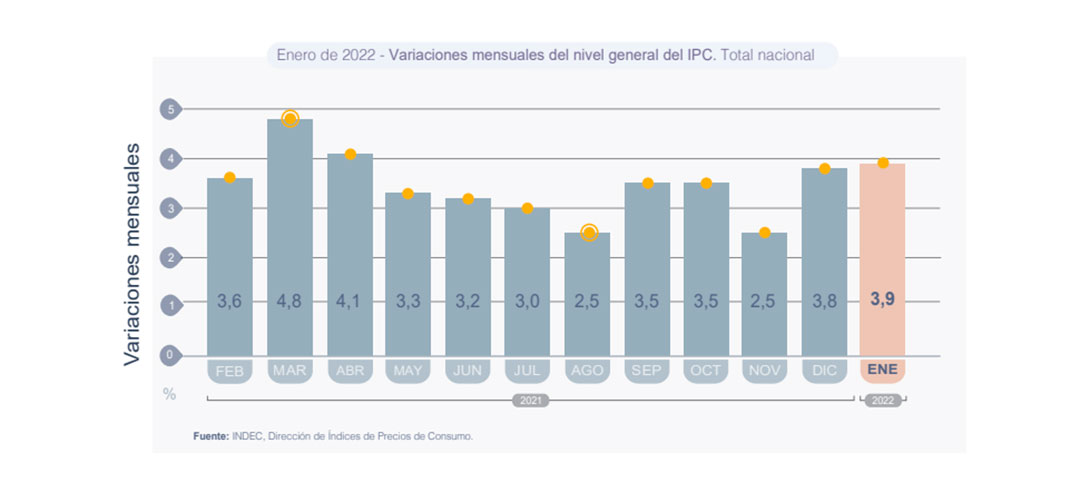INDEC will release today at 16 o'clock the inflation figure for February, which would stand at around 4% due to renewed pressure on food prices and the increase in fuels. The focus, however, is on March, where there would have been an inflationary peak that could bring the index to 5%, due to the strong impact caused by the rise in raw materials in the midst of the war between Russia and Ukraine.
Last month inflation performed quite similar to that of January, which showed an increase of 3.9%. In February, the increase in naphthas was added, adding a few tenths to the index. With the accumulated in the first two months, inflation will have exceeded 9%, that is, higher than the record of most Latin American countries throughout the year. Even Venezuela, which suffered hyperinflation for several years, shows better data than Argentina. In February, inflation rose to 2.9% in the Caribbean country.
Contrary to what had happened in the last months of 2021, what is driving inflation the most is now food prices, with the consequent impact on the basic basket. By January, the adjustment had reached almost 5% and something similar would have happened in February. In addition, March shows strong seasonality due to the start of classes and the change of season in clothing and footwear.

This confirms the fears of another very complicated year in terms of prices, which will worsen in March. Analysts are waiting for this month to peak from increases in commodity prices due to the war between Russia and Ukraine. Yesterday, without going any further, gasoline increased by 9.5% on average. And there are also strong increases in products such as flours and oils. Martín Guzmán himself acknowledged yesterday in the Senate that the war “is already impacting prices in Argentina.”
However, even before the war broke out, inflation had been accelerating in a dangerous way. It is true that the international situation adds pressure from all sides. Textiles complain about the increase in cotton, the industry in general suffers from sharp increases in raw materials for production, and freight prices have also risen again internationally. The concern in companies is, therefore, the high costs of inputs, beyond what is already happening with food. The increase in nickel and other metals, for example, is already being felt in production processes and is being passed on to the final consumer.
The agreement with the IMF establishes the lowering of inflation as one of the priorities. To that end, the Government is committed to gradually reducing the fiscal deficit and putting a brake on monetary issuance, which this year should fall from 3.7% to only 1%.
These are complex goals to achieve and markets are wary that they will actually be met. But even if this is the case, the reduction in inflation will be very gradual and the positive effects would only come closer to the end of the year.
The latest Market Expectations Survey yielded an annual inflation estimate of 55%. However, the estimation of the economic consultants had not included in that estimate the impact of the war on the price of raw materials, which is already strongly felt this month. Therefore, it would not be surprising if the next estimate is already closer to 60% by 2022.
The rate hike will also add pressure on prices, considering that the average increase for AMBA households would not drop below 45%. As for the rise in the official dollar, the Central Bank seems to have found a cruising speed of 3% per month, which will also have an impact on inflation over the months.
KEEP READING:
Últimas Noticias
Debanhi Escobar: they secured the motel where she was found lifeless in a cistern
Members of the Specialized Prosecutor's Office in Nuevo León secured the Nueva Castilla Motel as part of the investigations into the case

The oldest person in the world died at the age of 119
Kane Tanaka lived in Japan. She was born six months earlier than George Orwell, the same year that the Wright brothers first flew, and Marie Curie became the first woman to win a Nobel Prize

Macabre find in CDMX: they left a body bagged and tied in a taxi
The body was left in the back seats of the car. It was covered with black bags and tied with industrial tape
The eagles of America will face Manchester City in a duel of legends. Here are the details
The top Mexican football champion will play a match with Pep Guardiola's squad in the Lone Star Cup

Why is it good to bring dogs out to know the world when they are puppies
A so-called protection against the spread of diseases threatens the integral development of dogs




